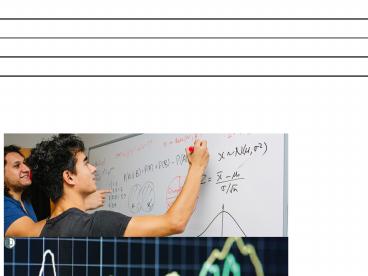Randomisation PowerPoint PPT Presentation
1 / 10
Title: Randomisation
1
Randomisation
- Surveys should use some form of random sampling
to obtain a representative sample - Randomisation avoids subjective and other biases
- Randomisation allows the calculation of likely
size of the sampling error estimates.
Simple Random Sampling(SRS)
- Label each population member from 1 to N and
sample without replacement in a random way using
a - Lottery method
- Random Number tables
- Computer
2
Other types of sampling
- Stratified sampling
- Population is made up of different strata
- A sub sample is selected from each stratum using
SRS - The combined sub samples form your sample
- E.g. Looking at average net profit of companies
listed on the NZSE. Using annual reports we can
classify the companies into large, medium and
small. These categories form our strata - Cluster sampling
- Population is made up of distinct clusters
- Randomly select some clusters and then sample
from each cluster - E.g. Take a list of towns in NZ (pop. lt 20,000)
and choose some at random - In each selected town get a list of streets and
choose some at random - In each selected street get a list of the houses
and choose some at random - Ask each selected household some questions
- Systematic sampling
- Take every kth unit.
- Often used in biological sciences
3
Errors in surveys
- Sampling errors are
- Errors caused by the act of take the sample
- The difference between the sample values and the
population value - Bigger in smaller samples than in larger ones
- Unavoidable (the cost of taking a sample)
- Can be minimised (but never removed) by careful
design of the sampling scheme - E.g. TV3/CM Research Poll sample 1,500 people
with a 3 margin of error - The margin of error is an estimate of how large
the sampling error is likely to be
4
Non-sampling errors
- Can be much larger than sampling errors
- Always present
- It is virtually impossible to determine how badly
they will affect the results - It is almost impossible to correct for
non-sampling errors after the survey has been
completed - Therefore, we must try to minimise non-sampling
errors when designing the survey - That is we use a pilot survey (if possible) to
expose the flaws or potential flaws in the survey
design
5
Selection bias
- The sampling mechanism does not allow every unit
in the population to be selected - E.g. A telephone survey is a possible source of
selection bias because the selection method
excludes all those people not in the phone book
Self-Selection bias
- The sampling mechanism allows units to select
themselves for the survey - A suggestion box is an example of self-selection
bias - Many behavioural research studies, especially
those concerning areas such as sexual habits have
selection biases
6
Non-response bias
- Non-response occurs in three ways
- Non-coverage ? Selection bias
- Item non-response failure to answer a question
on a survey - Unit non-response failure to respond to the
whole survey - Item non-response usually occurs when questions
are of a sensitive nature. - E.g. Please state your income so we can see
whether you owe more tax than you paid - Unit non-response usually occurs when there is
little or no incentive to respond. - Mail-in surveys often suffer from unit
non-response - Telephone surveys
7
Question effects
- 18 Aug 1980, NY Times/CBS News Poll
- Do you think there should be an amendment to
the constitution prohibiting abortions? - 29 Yes, 62 No
- Later the sample people were asked
- Do you think there should be an amendment to
the constitution protecting the life of the
unborn child? - 50 Yes, 39 No
8
Interviewer effects
- In 1968, one year after a major racial
disturbance in Detroit, a sample of black
residents were asked - Do you personally feel that you can trust most
white people, some white people or none at all? - White interviewer 35 answered most
- Black interviewer 7 answered most
- Interviewers should be non-threatening.
- Studies have shown that women make the best
interviewers
9
Behavioural considerations
- People may behave differently because they think
they will get in trouble - E.g. Official vote counts show 86.5 million
people voted in the 1980 US presidential
elections - A Census Bureau survey of 64,000 households some
weeks later estimated 93.1 million people voted.
Transfer of findings
- Is it valid to apply the findings of a survey
conducted on one population to another? - Generally not.
- E.g if a survey about the amount of fruit eaten
is conducted in the US could we use the results
for New Zealand?
10
Survey format
- Consider a subject you find embarrassing.
- Now suppose youre involved in a survey about
that subject - Will your answer to various questions differ if
the survey uses - A face to face interview
- A telephone poll
- questionnaires to be mailed back

